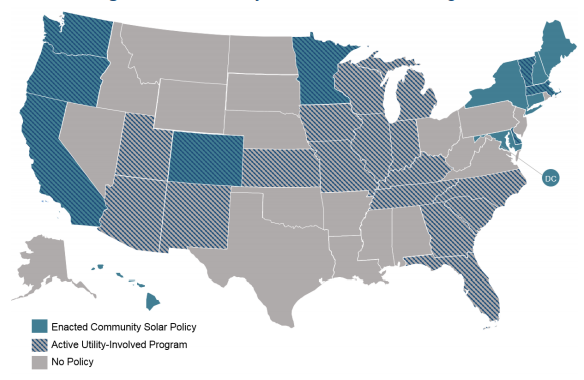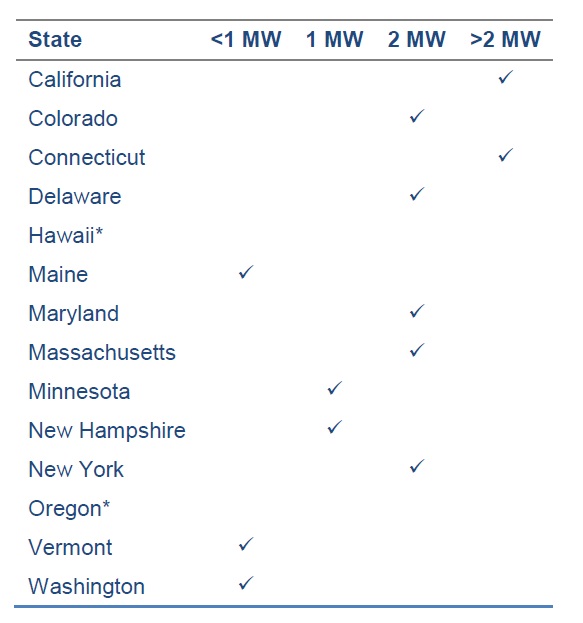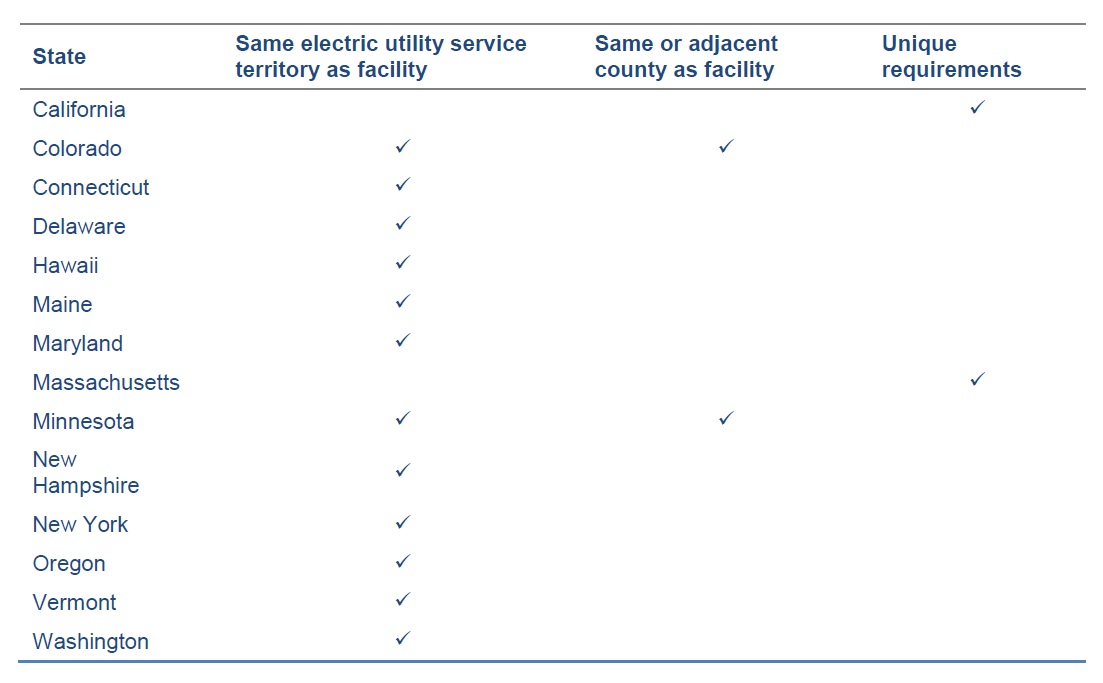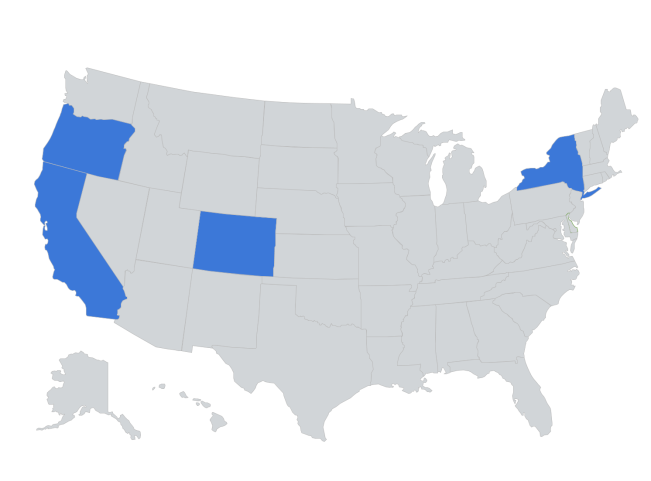Understanding Some Key Differences in Community Solar Policy across the States
June 2, 2016 by Jeffrey J. Cook
Poised to become a major contributor to future growth of the solar market by 2020, community solar programs have been established in 30 states across the country, as illustrated in the figure to the right.[i] This blogpost addresses some of the key policy differences across the 14 states where statewide community solar programs have been enacted or otherwise implemented.[ii]
The focus on these states is warranted given that the majority of community solar development has occurred in these 14 states. Though these states are similar in terms of community solar expansion, there is significant variation in the design of their community solar policies.
While some differences are inevitable given the unique characteristics and policy goals of each state, this policy variation can make it difficult for community solar developers operating across these states to understand how they can participate in a given market.
To address some of these challenges, this post compares the 14 states' policies in relation to three key policy categories: individual project size (or capacity) limitations, residential customer eligibility requirements, and low-income stipulations.[iii] These categories are important because of the potential impact each has on state markets related to potential installed capacity and customer base expansion.
Individual Project Size Limitations
The established individual project size limitation across each state is an important consideration for solar providers, as this can impact the economics of project development. Larger projects may cost less per subscriber because of the economies of scale associated with building one larger project over building several smaller projects. These size limits vary, in some cases widely, across the states as displayed in Table 1.
California has the highest size limit for an individual project at 20 megawatts (MW) and Washington has the lowest at 75 kilowatts (kW). Within this range, five states set their individual project capacity limit at 2 MW.[iv]
Table 1. Individual Project Size Limit by State[v]
*Individual project size limits have not yet been established in Oregon or Hawaii.
Residential Customer Eligibility Limitations
In addition, to addressing the size of individual projects, some states have placed limits on the customers that can subscribe to a solar project. These restrictions can influence the customer base available for solar developers to identify and secure subscribers. The focus here is on residential subscriber limitations, which vary across the states, as displayed in Table 2.
Table 2. Customer Eligibility for certain Community Solar Facilities by State
Most commonly, these policies require that eligible residential customers and the community shared solar facility be located within the same electric utility service territory (Connecticut, Delaware, Hawaii, Maine, Maryland, New Hampshire, New York, Oregon, Vermont, and Washington).[vi] Two (Colorado and Minnesota) are more restrictive and limit customer eligibility by requiring that subscribers be located in the same utility service territory and within the same or an adjacent county to the facility.
The remaining two states (California and Massachusetts) also impose limitations, but each is unique. California requires that community solar facilities be “reasonably proximate” to subscribers, but legislators did not define this concept.[vii] In comparison, Massachusetts limits participation to “neighborhoods.” [viii] Though this term is defined in statute, it is unclear how much total geographic area can be covered.
Low-income Deployment and Subscriber Requirements
Finally, four states specifically address low-income deployment and participation in their policies (figure to the right) and this can impact how providers market and site their facilities.
California’s approach is somewhat unique as it requires that 100 MW of the 600 MW community solar program be located in “disadvantaged communities.”[ix] However, it is unclear, whether the subscribers to these solar programs must also be low-income customers given the vague language noted above. In comparison, Colorado, New York, and Oregon directly mandate that 5% – 20% of subscribers be low or moderate-income customers.[x]
Ultimately, it is clear that state policies addressing community solar vary significantly across the country. Understanding these differences is important for solar developers’ business decision making as it relates to investing resources in market expansion going forward. Policy-makers may also want to consider harmonizing their policies with existing community solar programs when they are creating new programs or revising existing ones to ensure the program achieves legislative goals by adopting features of successful programs elsewhere.
[i] Community solar or shared solar programs allow certain customers who may not be able to host a solar photovoltaic system on their property to procure solar energy from a jointly-owned system. See: https://www.nrel.gov/docs/fy15osti/63892.pdf.
[ii] Most states have adopted or authorized community solar programs by enacting new community solar-related laws, while New York adopted its program via regulation. See: http://www.nyserda.ny.gov/All-Programs/Programs/NY-Sun/Communities/Shared-Solar.
[iii] For more information on these and other policy differences see: http://sharedrenewables.org/community-energy-projects/ and http://spotforcleanenergy.org/policy/shared-renewables/.
[iv] See: http://sharedrenewables.org/community-energy-projects/.
[v] The information from this table is derived from http://sharedrenewables.org/community-energy-projects/ and state statute or regulation.
[vi] Some of these policies also limit community solar programs to certain utilities as is the case in Delaware.
[vii] See: http://leginfo.legislature.ca.gov/faces/billNavClient.xhtml?bill_id=201320140SB43.
[viii] See: https://malegislature.gov/Laws/SessionLaws/Acts/2008/Chapter169.
[ix] See: http://leginfo.legislature.ca.gov/faces/billNavClient.xhtml?bill_id=201320140SB43.
[x] This requirement applies in New York, unless the developer can demonstrate that the project’s location provides the greatest benefits to the electricity grid. See: http://documents.dps.ny.gov/public/Common/ViewDoc.aspx?DocRefId=%7b76520435-25ED-4B84-8477-6433CE88DA86%7d.
Share





